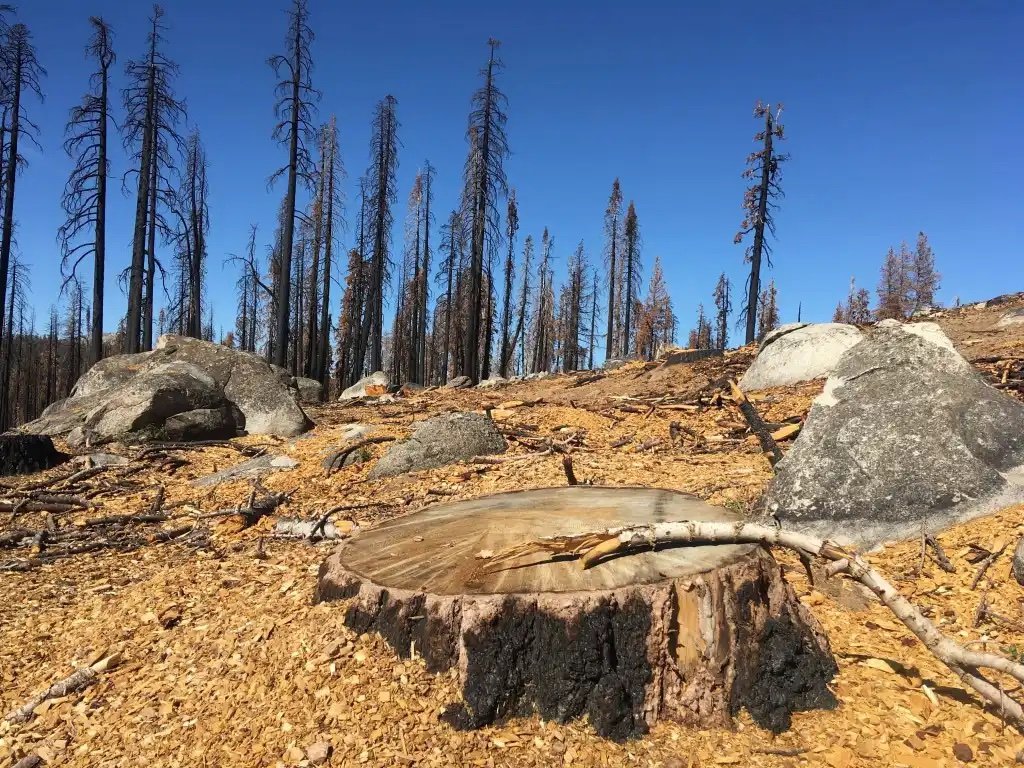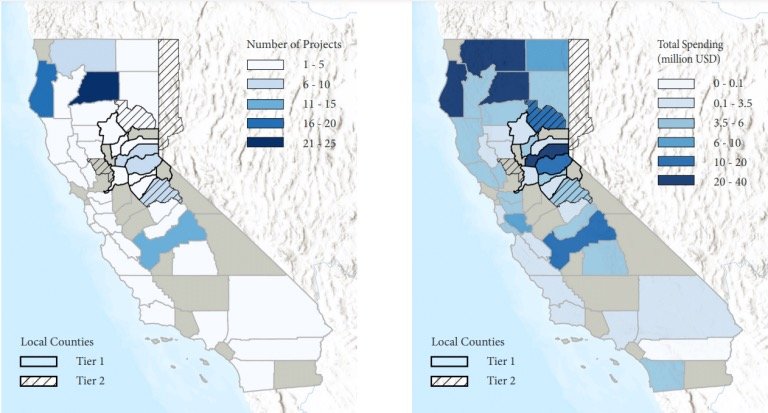Funding Vs. Challenges In Forest Restoration
Public and private land managers, non-profits like the Sugar Pine Foundation, and other entities have been engaged in forest restoration for decades. Yet the concept only recently gained public and political attention and the term “forest restoration” became somewhat of a buzzword when intense wildfires in 2020 and 2021 wreaked havoc across the West and people sought a solution to turn to.
Forest restoration is not an immediate fix or panacea for over-stocked forests that have not experienced beneficial fire in over a century and which are threatened by increased heat, drought and fire potential due to climate change – but it is ecologically and economically worthwhile nevertheless.
The aims of forest restoration – to increase forest resilience and reduce catastrophic risk through ecologically informed thinning, burning, and planting – are necessarily broad, deep, labor-intensive and far-reaching over a long time scale.
Increased support for forest restoration is a positive trend because it helps shed light on the foundational importance of ecological health. We absolutely need healthy forests because they sustain healthy watersheds, healthy wildlife populations, healthy economies, and healthy human communities.
Another plus is vastly increased public funding for forest restoration activities.
When the extreme wildfire events of 2020 and 2021 underlined the importance of strengthening forest restoration and management programs in California, the state and federal governments responded with impressive alacrity by pumping unprecedented amounts of new funding into forest management.
In 2020, California entered into a Shared Stewardship Agreement with the US Forest Service (USFS) which aims to implement restoration activities on 1 million acres a year—half on state lands and half on USFS lands – for 10 years. This agreement is meant to build the necessary infrastructure and workforce to carry out the thinning of smaller trees and brush (often in combination with commercial timber harvesting), as well as prescribed beneficial fire treatments and Indigenous cultural burning.
In January of 2022 California also initiated a record $2.7 billion four-year investment in wildfire resilience programs. This funding package added support to the state’s proactive forest restoration grant programs, many of which are funded through the state’s carbon markets via the Greenhouse Gas Reduction Fund (GGRF). Tahoe area residents likely saw projects funded by such monies already taking place in their nearby forests this summer.
In May of 2022 the California Air Resources Board further proposed restoration treatments across 2–2.5 million acres of forest and shrublands every year, which represents an almost tenfold increase above pre-2022 state treatment levels. This forward-looking proposal accounts for the fact that treated forests are less likely to burn and release massive amounts of stored carbon into the atmosphere. Forest treatments are thus a worthwhile investment that effectively reduce carbon emissions and contribute to the state’s climate policy goals.
Pumping funding into increasing the pace and scale of forest restoration promises not only to keep carbon sequestered, reduce wildfire severity, and protect towns, businesses and homes but also to create jobs in forest-based industries at the foundation of rural restoration economies that will sustain and enhance forest resilience, watersheds, and local communities.
Despite these benefits and unprecedented levels of financial and political support, implementing more widespread forest restoration does face many challenges.
Last year, we participated in a survey by a Climate and Community Project (CCP) team researching forest restoration in the Tahoe and Central Sierra region. Their recently published study, entitled “High Roads to Resilience: Building Equitable Forest Restoration Economies in California and Beyond,” elucidates many forest industry trends and hurdles, and proposes holistic policies and solutions to facilitate restoration at a greater pace and scale.
As the CCP study describes, limited workforce capacity is the biggest challenge to achieving forest management goals. Forestry labor requires skilled, often placed-based knowledge that is undervalued and in limited supply. Forest restoration and fire suppression both rely on heavy machinery and skilled equipment operators are especially in demand. Heavy equipment operators, pilots and sawyers require significant experience and/or on-the-job training, so boosting training opportunities to build a qualified forest industry labor force is needed. At the same time, government agencies like the US Forest Service (USFS) and the Bureau of Land Management (BLM) are critically understaffed, making it harder to plan for, implement and manage forest restoration projects.
The main reasons why contractors and government agencies are suffering labor shortages are: low wages, forestry work conditions are difficult and dangerous, and seasonal work is less desirable than year-round full-time work. High housing and transportation costs are a barrier to attracting new recruits to the industry, particularly in high-tourism areas like Tahoe, Truckee, and Nevada City. Forestry contractors and even government agencies find it hard to compete with warehouse, retail, and fast-food employers for workers, especially when wages are similar but the work is easier and more consistent. Skilled workers can also find higher paying, unionized jobs with utilities and other companies.
A prominent yet often-overlooked workforce issue is that incarcerated firefighters make up about 33% of California’s fire suppression workforce but face significant barriers to regular employment in the forestry industry as returning citizens because the certifications they receive in prison fire camp are not directly transferable to post-incarceration employment and state that they were gained while in prison, which further decreases their chances of being hired.
The upshot is that increased wages, harmonized (reciprocally recognized and accepted) certification programs, apprenticeships and on-the-job trainings are needed industry-wide to build a diverse, fairly compensated and robust workforce for carrying out forest treatments, despite what will be increased costs of forest treatments. A good use for state funding is to put it towards providing education, training, and career pathway programs to attract and retain valuable forest industry employees.
Not surprisingly, the CCP study identified that within the Central Sierra study region, the Tahoe-Truckee area receives more funding than other nearby rural, mountainous, heavily forested counties with similar forest management needs. In fact, El Dorado and Placer counties enjoy among the highest-value restoration projects statewide.
Frequency and value of GGRF-funded projects across California, 2015-2021.
Source: High Roads to Resilience: Building Equitable Forest Restoration Economies in California and Beyond
Whereas our region is benefiting from forest treatments, unfortunately the CCP study found that the majority of forestry spending was distributed unevenly, going predominantly to a few companies for equipment-intensive (rather than labor-intensive) fire suppression activities. Forest restoration is inherently labor-intensive, however, which is why training a larger, more diverse workforce to carry out this work is essential. More good news for our region is that the Lake Tahoe Community College in South Lake Tahoe launched its Forestry Program Fall of 2022 and recently secured $1.2 million in funding to support the Forestry and Fire Programs.
While funding and workforce issues are at the very core of increasing the pace and scale of forest restoration work, other imperatives and attendant issues outlined in the CCP study include:
Expanding wood products infrastructure to process merchantable timber removed in thinning operations and from burn scars as well as sub-timber biomass that may be used for energy generation. Again, in our region, we are fortunate that a new mill in Carson City is set to start operations in 2023.
Fostering cultural burning and Tribal engagement in managing current and former ancestral lands
Addressing liability issues and the high cost of insurance policies around prescribed burning in order to develop a more robust beneficial fire industry and workforce
Reforming a problematic state grant funding structure that requires contactors to outlay significant capital to complete forest restoration projects before they are reimbursed for the work
Enhancing local capture of restoration contracts to build rural restoration economies
The overarching message of the CCP study is, “This pivotal moment presents a major opportunity for transformative forest management that is socially and ecologically restorative.” Funding much-needed forest restoration is central to fostering a more ecologically, socially and economically sound future in our region and elsewhere.
In Tahoe, we are fortunate to see the fruits of public and political support for increased forest restoration happening already – and we are already reaping the rewards. For example, forest treatments conducted prior to the notorious Caldor Fire helped critically slow the fire outside Kirkwood and avert disaster in Christmas Valley.
Because the benefits of forest restoration are so tangible and numerous at so many levels, our hope is that the success of restoration projects and their ramifications in Tahoe-Truckee will continue to spread – like beneficial fire, one might say – both within our vicinity, throughout California, and beyond.
1458 Mt. Rainier Drive, South Lake Tahoe, CA 96150 | (650) 814-956five | admin@sugarpinefoundation.org






